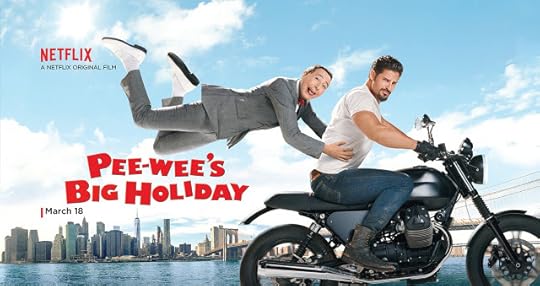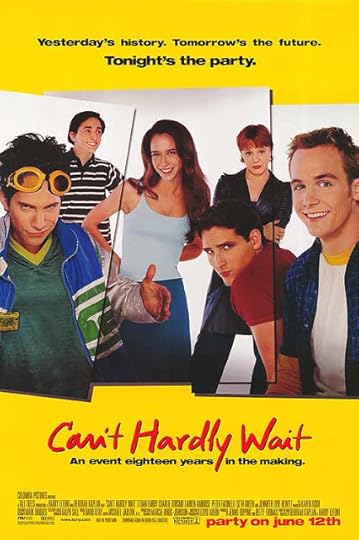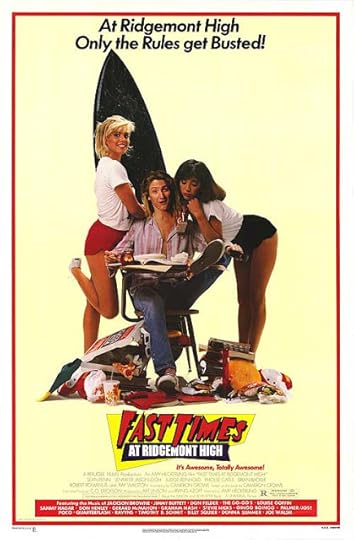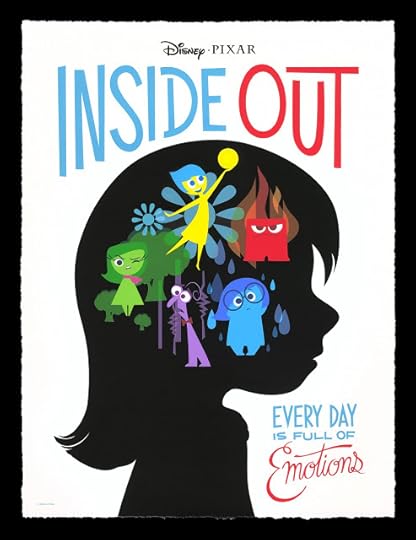Movies I Watched in March, Part 2
The March recap continues...

It’s no “Big Adventure” (a movie that has held up amazingly well, in my humble opinion), but it’s a lot of fun in its own right, delivering just the sort of knowing whimsy that you’re looking for in something from the esteemed Mr. Reubens. I was a little concerned that “Big Holiday” would be a simple retread of “Big Adventure” when the movie opened in Pee-Wee’s gadget-laden house, but that’s not the case. Even though the movie follows Pee-Wee on a cross-country journey full of colorful characters, it has a different feel than the earlier film. It’s a little more laid-back, as befits the older (but not necessarily more mature) Pee-Wee, and the premise that Pee-Wee is afraid to leave his beloved (and lovingly retro) hometown actually allows for a tiny bit on personal growth on the part of our hero. The reason for his departure is so simple that it’s one of the best jokes in the movie: Actor Joe Manganiello stops by Pee-Wee’s diner and invites him to his birthday party in Manhattan. Sensing a connection to his new friend (they both love root beer barrel candies), he has no choice but to be brave and hit the road. Along the way, of course, he meets various folks who either impede or assist his progress, including a gang of Russ Meyer-inspired female criminals and a rich, eccentric pilot (played by Diane Salinger, who played Simone in “Big Adventure” and is, as far as I can tell, the only actor – besides Reubens, of course – to appear in both movies.) It’s a lot of fun, never wears out its welcome and suitable for all ages. What more do you want in a movie? It says something about comedy, by the way, and about the unique appeal of Pee Wee Herman, that in a movie full of funny moments, the funniest is a simple, single-take scene involving Pee Wee and a slowly deflating balloon. It's legitimately great.

In case you're wondering, I watched this one for our teen movie episode of Out ofTheaters. I’d never seen it before, but apparently it’s quite the touchstone film among my younger, millennial cohorts. It looked like every other PG-13 teen movie to me, with the stock characters of the nerd, the beauty, the bully, the weird girl and the white kid trying to be black (who apparently has replaced the stoner, a beloved component of the movies of my youth). The entire story takes place at one of those mythical end-of-the-school-year parties, and during the first several minutes I felt the urge to kill each and every character in the film. Eventually, things calmed down, the various tried-and-true storylines started to sort themselves out, and I hated the movie a little bit less. (But just a little.) Thing is, nothing surprised me in this movie – not the characters who hooked up, not the way our hero eventually got his dream girl and not the way the nerd got drunk and became a hit with the ladies. Teen movies are like creation myths, retold in slightly different ways for each new generation, but “Can’t Hardly Wait” just didn’t connect with me at all – not as a moviegoer, a former teenager or someone looking for any tiny bit of entertainment buried under all the Smashmouth music. Maybe I’m just old. Or maybe this movie’s just bad.
 I’ll bet my younger podcast compadres felt the same way about my teen movie pick, 1982’s “Fast Times at Ridgemont High.” (In fact, I’m sure they did – listen to them complain about it here.) And maybe I hold this movie in too high esteem, having first seen it on VHS in my own teens (after failing to sneak into it during its original theatrical run.) Still, “Fast Times” just seems to have more meat on its bones than “Can’t Hardly Wait,” trying to paint a picture of what it’s actually like to be in high school (or, at least what it was like, back in the early ‘80s) than wring some easy jokes out of a far-fetched party scenario. I went to school in northern Ohio, not southern California, but this movie feels right to me, with the kids acting like real kids and the scenes feeling like they could happen. (Cameron Crowe famously went undercover in an actual high school and wrote the book that led to the movie.) Both movies have their “serious” moments, but Jennifer Jason Leigh’s matter-of-fact abortion says more about teen angst than all the moping Ethan Embry does over Jennifer Love Hewitt. Plus, there’s something about an R-rating that elevates a teen movie. Teens, probably more than any other group, talk and behave in R-rating ways, even if they’re not quite sure what they’re doing. Sanitizing that to get a PG-13 makes the whole thing feel false. Plus, if you’re going to have Phoebe Cates remove her red bikini to the tune of the Cars’ “Moving in Stereo,” you want that R. Trust me.
I’ll bet my younger podcast compadres felt the same way about my teen movie pick, 1982’s “Fast Times at Ridgemont High.” (In fact, I’m sure they did – listen to them complain about it here.) And maybe I hold this movie in too high esteem, having first seen it on VHS in my own teens (after failing to sneak into it during its original theatrical run.) Still, “Fast Times” just seems to have more meat on its bones than “Can’t Hardly Wait,” trying to paint a picture of what it’s actually like to be in high school (or, at least what it was like, back in the early ‘80s) than wring some easy jokes out of a far-fetched party scenario. I went to school in northern Ohio, not southern California, but this movie feels right to me, with the kids acting like real kids and the scenes feeling like they could happen. (Cameron Crowe famously went undercover in an actual high school and wrote the book that led to the movie.) Both movies have their “serious” moments, but Jennifer Jason Leigh’s matter-of-fact abortion says more about teen angst than all the moping Ethan Embry does over Jennifer Love Hewitt. Plus, there’s something about an R-rating that elevates a teen movie. Teens, probably more than any other group, talk and behave in R-rating ways, even if they’re not quite sure what they’re doing. Sanitizing that to get a PG-13 makes the whole thing feel false. Plus, if you’re going to have Phoebe Cates remove her red bikini to the tune of the Cars’ “Moving in Stereo,” you want that R. Trust me.

I’d argue “Inside Out” is one of Pixar’s very best, ranking right up there with “Toy Story 3,” “Finding Nemo” and “The Incredibles.” It’s beautifully animated, of course, with the emotions having a distinct fuzziness that separates them from the real world, and with the real world having some of the most well-executed human beings ever seen in computer animation. (They could never have done this one back in the days of the original “Toy Story.”) But it’s the writing that elevates this movie, showcasing a simple, believable portrait of an average girl on the brink of adolescence and the conflicting emotions that rule her life and drive her actions. The more you break it down, the more admirably complex it all is, but the reason it succeeds so well is that it works on – fittingly enough – an emotional level. You care about the emotions themselves, especially Joy and Sadness; you care about the soon-to-be-forgotten imaginary friend; and you care about Riley, the girl the entire story takes place inside. It’s smart, too, the way the movie plays with your own expectations. Of course any parent would want their kid to be happy all the time, but as “Inside Out” demonstrates, sometimes you have to be sad, for big reasons and small. As the father of a girl just a little younger than Riley, I completely connect with the parents of the movie, wanting to protect their kid from everything but knowing that isn’t how life works – and it isn’t even how life should work. “Inside Out,” in its own, funny little way, is more perceptive about the world than most movies allegedly aimed at adults. It’s everything a family film should be, in every sense of the word.

It’s no “Big Adventure” (a movie that has held up amazingly well, in my humble opinion), but it’s a lot of fun in its own right, delivering just the sort of knowing whimsy that you’re looking for in something from the esteemed Mr. Reubens. I was a little concerned that “Big Holiday” would be a simple retread of “Big Adventure” when the movie opened in Pee-Wee’s gadget-laden house, but that’s not the case. Even though the movie follows Pee-Wee on a cross-country journey full of colorful characters, it has a different feel than the earlier film. It’s a little more laid-back, as befits the older (but not necessarily more mature) Pee-Wee, and the premise that Pee-Wee is afraid to leave his beloved (and lovingly retro) hometown actually allows for a tiny bit on personal growth on the part of our hero. The reason for his departure is so simple that it’s one of the best jokes in the movie: Actor Joe Manganiello stops by Pee-Wee’s diner and invites him to his birthday party in Manhattan. Sensing a connection to his new friend (they both love root beer barrel candies), he has no choice but to be brave and hit the road. Along the way, of course, he meets various folks who either impede or assist his progress, including a gang of Russ Meyer-inspired female criminals and a rich, eccentric pilot (played by Diane Salinger, who played Simone in “Big Adventure” and is, as far as I can tell, the only actor – besides Reubens, of course – to appear in both movies.) It’s a lot of fun, never wears out its welcome and suitable for all ages. What more do you want in a movie? It says something about comedy, by the way, and about the unique appeal of Pee Wee Herman, that in a movie full of funny moments, the funniest is a simple, single-take scene involving Pee Wee and a slowly deflating balloon. It's legitimately great.

In case you're wondering, I watched this one for our teen movie episode of Out ofTheaters. I’d never seen it before, but apparently it’s quite the touchstone film among my younger, millennial cohorts. It looked like every other PG-13 teen movie to me, with the stock characters of the nerd, the beauty, the bully, the weird girl and the white kid trying to be black (who apparently has replaced the stoner, a beloved component of the movies of my youth). The entire story takes place at one of those mythical end-of-the-school-year parties, and during the first several minutes I felt the urge to kill each and every character in the film. Eventually, things calmed down, the various tried-and-true storylines started to sort themselves out, and I hated the movie a little bit less. (But just a little.) Thing is, nothing surprised me in this movie – not the characters who hooked up, not the way our hero eventually got his dream girl and not the way the nerd got drunk and became a hit with the ladies. Teen movies are like creation myths, retold in slightly different ways for each new generation, but “Can’t Hardly Wait” just didn’t connect with me at all – not as a moviegoer, a former teenager or someone looking for any tiny bit of entertainment buried under all the Smashmouth music. Maybe I’m just old. Or maybe this movie’s just bad.
 I’ll bet my younger podcast compadres felt the same way about my teen movie pick, 1982’s “Fast Times at Ridgemont High.” (In fact, I’m sure they did – listen to them complain about it here.) And maybe I hold this movie in too high esteem, having first seen it on VHS in my own teens (after failing to sneak into it during its original theatrical run.) Still, “Fast Times” just seems to have more meat on its bones than “Can’t Hardly Wait,” trying to paint a picture of what it’s actually like to be in high school (or, at least what it was like, back in the early ‘80s) than wring some easy jokes out of a far-fetched party scenario. I went to school in northern Ohio, not southern California, but this movie feels right to me, with the kids acting like real kids and the scenes feeling like they could happen. (Cameron Crowe famously went undercover in an actual high school and wrote the book that led to the movie.) Both movies have their “serious” moments, but Jennifer Jason Leigh’s matter-of-fact abortion says more about teen angst than all the moping Ethan Embry does over Jennifer Love Hewitt. Plus, there’s something about an R-rating that elevates a teen movie. Teens, probably more than any other group, talk and behave in R-rating ways, even if they’re not quite sure what they’re doing. Sanitizing that to get a PG-13 makes the whole thing feel false. Plus, if you’re going to have Phoebe Cates remove her red bikini to the tune of the Cars’ “Moving in Stereo,” you want that R. Trust me.
I’ll bet my younger podcast compadres felt the same way about my teen movie pick, 1982’s “Fast Times at Ridgemont High.” (In fact, I’m sure they did – listen to them complain about it here.) And maybe I hold this movie in too high esteem, having first seen it on VHS in my own teens (after failing to sneak into it during its original theatrical run.) Still, “Fast Times” just seems to have more meat on its bones than “Can’t Hardly Wait,” trying to paint a picture of what it’s actually like to be in high school (or, at least what it was like, back in the early ‘80s) than wring some easy jokes out of a far-fetched party scenario. I went to school in northern Ohio, not southern California, but this movie feels right to me, with the kids acting like real kids and the scenes feeling like they could happen. (Cameron Crowe famously went undercover in an actual high school and wrote the book that led to the movie.) Both movies have their “serious” moments, but Jennifer Jason Leigh’s matter-of-fact abortion says more about teen angst than all the moping Ethan Embry does over Jennifer Love Hewitt. Plus, there’s something about an R-rating that elevates a teen movie. Teens, probably more than any other group, talk and behave in R-rating ways, even if they’re not quite sure what they’re doing. Sanitizing that to get a PG-13 makes the whole thing feel false. Plus, if you’re going to have Phoebe Cates remove her red bikini to the tune of the Cars’ “Moving in Stereo,” you want that R. Trust me.

I’d argue “Inside Out” is one of Pixar’s very best, ranking right up there with “Toy Story 3,” “Finding Nemo” and “The Incredibles.” It’s beautifully animated, of course, with the emotions having a distinct fuzziness that separates them from the real world, and with the real world having some of the most well-executed human beings ever seen in computer animation. (They could never have done this one back in the days of the original “Toy Story.”) But it’s the writing that elevates this movie, showcasing a simple, believable portrait of an average girl on the brink of adolescence and the conflicting emotions that rule her life and drive her actions. The more you break it down, the more admirably complex it all is, but the reason it succeeds so well is that it works on – fittingly enough – an emotional level. You care about the emotions themselves, especially Joy and Sadness; you care about the soon-to-be-forgotten imaginary friend; and you care about Riley, the girl the entire story takes place inside. It’s smart, too, the way the movie plays with your own expectations. Of course any parent would want their kid to be happy all the time, but as “Inside Out” demonstrates, sometimes you have to be sad, for big reasons and small. As the father of a girl just a little younger than Riley, I completely connect with the parents of the movie, wanting to protect their kid from everything but knowing that isn’t how life works – and it isn’t even how life should work. “Inside Out,” in its own, funny little way, is more perceptive about the world than most movies allegedly aimed at adults. It’s everything a family film should be, in every sense of the word.
Published on April 11, 2016 16:46
No comments have been added yet.
Will Pfeifer's Blog
- Will Pfeifer's profile
- 23 followers
Will Pfeifer isn't a Goodreads Author
(yet),
but they
do have a blog,
so here are some recent posts imported from
their feed.



